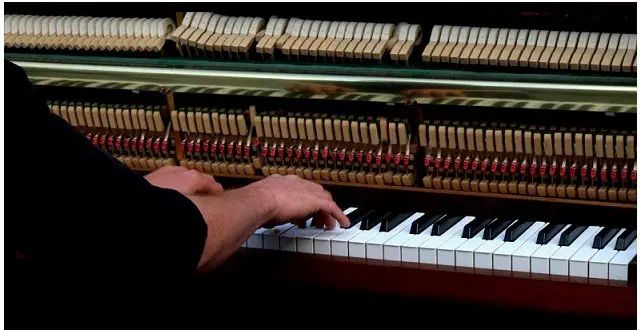
Everything you need to know about the black keys on the piano. Welcome to the world of flats and sharps.
A piano has a series of white and black keys. But if you have recently started learning to play the piano, for a few months you’re unlikely to use most of the black keys on the piano.
Almost every students starts by learning the notes on the piano, and these are all the white keys (of the C scale).
Read: Learn the Notes on the Piano
Even when you start playing simple songs and pieces, those are based on either the C scale (all white keys), the F scale (uses one black key) or the G scale (uses one black key).
So I am sure most beginners are intrigued by the black keys and are keen to know when they will start playing on those.
The fact is that just like you have the C, F, G scale, there are many more scales in music and as you progress and learn to play those scales, you will eventually reach a point where you will play a lot of those black keys as well.
For example, if a song is based on the C# or the F# scale, it will use all those black keys.
Flats: Black keys to the left of white keys are called flats (Bb, Ab, Gb, Eb and Db)
Sharps: Black keys to the right of a white keys are called sharps (C#, D#, F#, G#, A#)
Read: Accidentals explained (Sharps and Flats)
Another reason why most piano songs are written for keys (scales) that require more of white keys, is because it’s comparatively easier to play on the white keys (because of the way the piano is designed).
When you learn typing on a computer, you are taught to rest your hands at a base position, from where it is easier to reach all the keys of the computer keyboard. Similarly, it is easier to place the fingers of your hands on the white keys and then play the black key as and when required.
Beginners who learn to play the harmonium (Indian keyboard instrument) start on the C# scale and almost never use the C scale (which has all white keys). Again, the design of the instrument plays an important role on this. With the left hand pressing the bellows, and the smaller sized keys (compared to that on a piano), its easier to keep your fingers on the black keys of a harmonium. And if you’re only going to use your right hand (for playing the melody), its comparatively easier to play a scale with several black keys.
But on a piano, its much more comfortable to place both your hands on the white keys, at least for most beginners and intermediate level players.
However, with practice, you can master the black keys as well on the piano.
So you will eventually reach that stage where the songs will require you to play several black keys of the piano. Until then, you should focus on the piano technique and learn to play the songs that require fewer black keys.
KeytarHQ editorial team includes musicians who write and review products for pianists, keyboardists, guitarists & other musicians. KeytarHQ is the best online resource for information on keyboards, pianos, synths, keytars, guitars and music gear for musicians of all abilities, ages and interests.



Leave a Reply